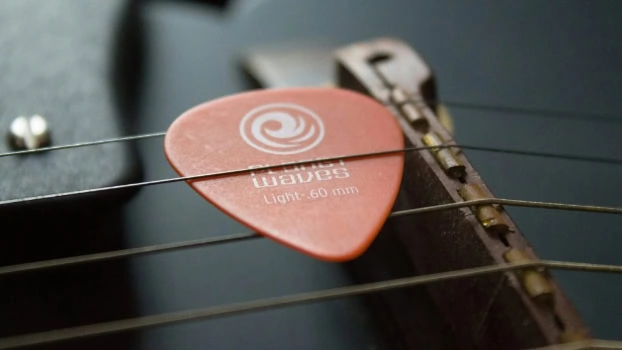
Understanding and exploring the most common guitar picking styles in rock music can elevate your playing to new heights. Picking isn’t just about making the strings vibrate; it’s the heart and soul of your guitar sound.
Have you ever noticed how some guitarists can effortlessly switch between styles, creating rich and varied musical textures? This is all about mastering different picking techniques.
These techniques can shape your tone, rhythm, and overall musical expression. Alternate picking can give your solos a razor-sharp edge, while fingerpicking can bring out the delicate, intricate patterns perfect for folk or classical pieces.

Let’s start with the basics. When we talk about guitar picking, we’re referring to how a guitarist strikes the strings to produce sound.
This can be done using a pick, or with your fingers, sometimes even a combination of both. Each method has its own unique sound and feel.
So, why should you care about picking styles? Simply put, it’s about versatility. The more techniques you master, the more styles you can play, and the more expressive your performance can be.
Whether you’re strumming at a campfire or shredding that epic guitar solo on stage, understanding and practicing different picking styles will make you a more well-rounded guitarist.
Ready to explore these styles and see how they can transform your playing? Let’s get into the nitty-gritty of alternate picking, sweep picking, fingerpicking, and advanced hybrid and economy picking. Grab your guitar and let’s get started.
Alternate picking is one of those essential skills every guitarist should master. This technique involves alternating between downstrokes and upstrokes, creating a fluid motion that can significantly boost your playing speed.
To get started, hold your pick comfortably between your thumb and index finger. Keep your wrist relaxed and focus on making smooth, controlled movements. It’s all about finding that sweet spot where speed and precision meet.
One major plus of alternate picking is that it’s incredibly versatile. Whether you’re playing fast lead lines, shredding solos, or riffing rhythm parts, this technique helps maintain a consistent, even tone. Plus, it makes your playing sound cleaner and more professional.
Practice is key here. Start slow, using a metronome to keep time. Gradually increase the speed as you become more comfortable. Exercises like chromatic runs or simple scales are great for developing this technique.
You’ve probably heard of guitar legends like Paul Gilbert and John Petrucci. They’re masters of alternate picking, and listening to their music can provide some serious inspiration. Notice how clean and precise their fast passages sound—that’s what alternate picking can help you achieve.
Sweep picking is like the magic trick of the guitar world. It’s all about creating a smooth, flowing sound by ‘sweeping’ your pick across multiple strings in a single motion. When done right, it can make your playing sound incredibly fluid and effortless.
Start by understanding the basics. Instead of picking each string individually like in alternate picking, you let your pick glide across the strings in an almost strumming motion. The key is to keep your movements economical—no wasted motion here. That’s what gives sweep picking its speed and fluidity.
Common mistakes include moving your wrist too much or not muting the strings properly, leading to a messy sound. To avoid this, make sure each note rings out cleanly. Use your fretting hand to lightly touch the strings you’re not playing to mute them, and practice slower at first to ensure you have control over each note.
To improve your sweep picking, try exercises like arpeggios in various shapes and positions. Begin with three-string sweeps before moving on to five-string and six-string patterns. Consistent practice with a metronome can help you build up speed without sacrificing clarity.
Some famous guitar solos that feature sweep picking include Yngwie Malmsteen’s ‘Far Beyond the Sun’ and Jason Becker’s ‘Altitudes.’ Listening to these tracks can give you a sense of what’s achievable with this technique.
Over time, as you get more comfortable, you’ll start incorporating sweep picking into your own solos for that ultra-smooth sound.
Here’s a picture of Yngwie Malmsteen playing live on stage with stacks of Marshall amplifiers behind him.
I took at the House of Blues in New Orleans. A bit blurry, but I still want to share it.

Listen to Yngwie Malmsteen sweeping on this short clip called….Liar!


Yngwie Malmsteen @House of Blues in New Orleans
Fingerpicking brings a unique, intimate quality to your guitar playing that’s perfect for acoustic music. Unlike using a pick, you use your fingers to pluck the strings, which allows for more intricate patterns and subtle dynamics.
The most noticeable difference between fingerpicking and traditional picking is the level of control. With fingerpicking, you can hit multiple strings simultaneously or in quick succession, creating a rich, textured sound. It’s like having a mini-orchestra at your fingertips.
Start with the basics: thumb on the bass strings (E, A, D) and your index, middle, and ring fingers on the G, B, and high E strings, respectively. Familiarize yourself with some essential patterns like the Travis picking style or basic arpeggios.
Practice these patterns slowly, ensuring each note is clean and clear. Over time, you can increase your speed and complexity, adding embellishments like hammer-ons, pull-offs, and slides. The goal is to maintain a steady rhythm while bringing out the melody and bass lines simultaneously.
Influential artists like James Taylor and Tommy Emmanuel have mastered fingerpicking, each bringing their own unique style to the technique. Listening to their music will give you a sense of the expressive possibilities fingerpicking offers. Try playing along with some of their songs to apply what you’ve learned.
Hybrid picking, aka “chicken picking”, blends the strengths of both fingerpicking and flatpicking, allowing you to switch seamlessly between the two. James Burton is considered the godfather of this technique and this type of picking was first heard way back in 1957.
Listen to this amazing solo! James Burton live in concert.

This technique involves holding a pick between your thumb and index finger while using your middle and ring fingers to pluck other strings. It opens up a whole new realm of possibilities, especially when it comes to complex, multi-string passages.
Start by practicing simple patterns where you pick the bass notes with your pick and pluck the higher notes with your fingers. It can feel a bit awkward at first, but with consistent practice, it becomes second nature.
Try out exercises that combine picking and plucking, focusing on keeping your motions precise and controlled.
Economy picking is another advanced technique that focuses on efficiency. Unlike alternate picking, where you switch directions with each pick stroke, economy picking employs a smoother approach.
You continue in the same direction when moving from one string to the next, minimizing movement and maximizing speed.
For example, if you’re playing a scale that moves from a lower string to a higher one, you’d use consecutive downstrokes, making your transitions smoother and faster.
It’s an efficient method for playing scales and arpeggios at lightning speed. You’ll still need to start slowly to get the hang of it, but the payoff in speed and fluidity is huge.
Some genres like jazz, country, and modern metal can particularly benefit from these advanced picking styles. Players like Jerry Reed, Eric Johnson, Guthrie Govan, Keith Urban, and Frank Gamble are renowned for their mastery of hybrid and economy picking, just to name a few.
Listening to their playing can give you practical insights into how to incorporate these techniques into your own music. So go and pick up your guitar of choice and get after it!

I’ve been playing guitar 40 years now; writing, recording, and rocking in bands. Randy Rhoads, Warren DiMartini, and of course, Jimi Hendrix all lit the fire for me, and I’ve been chasing that passion ever since.